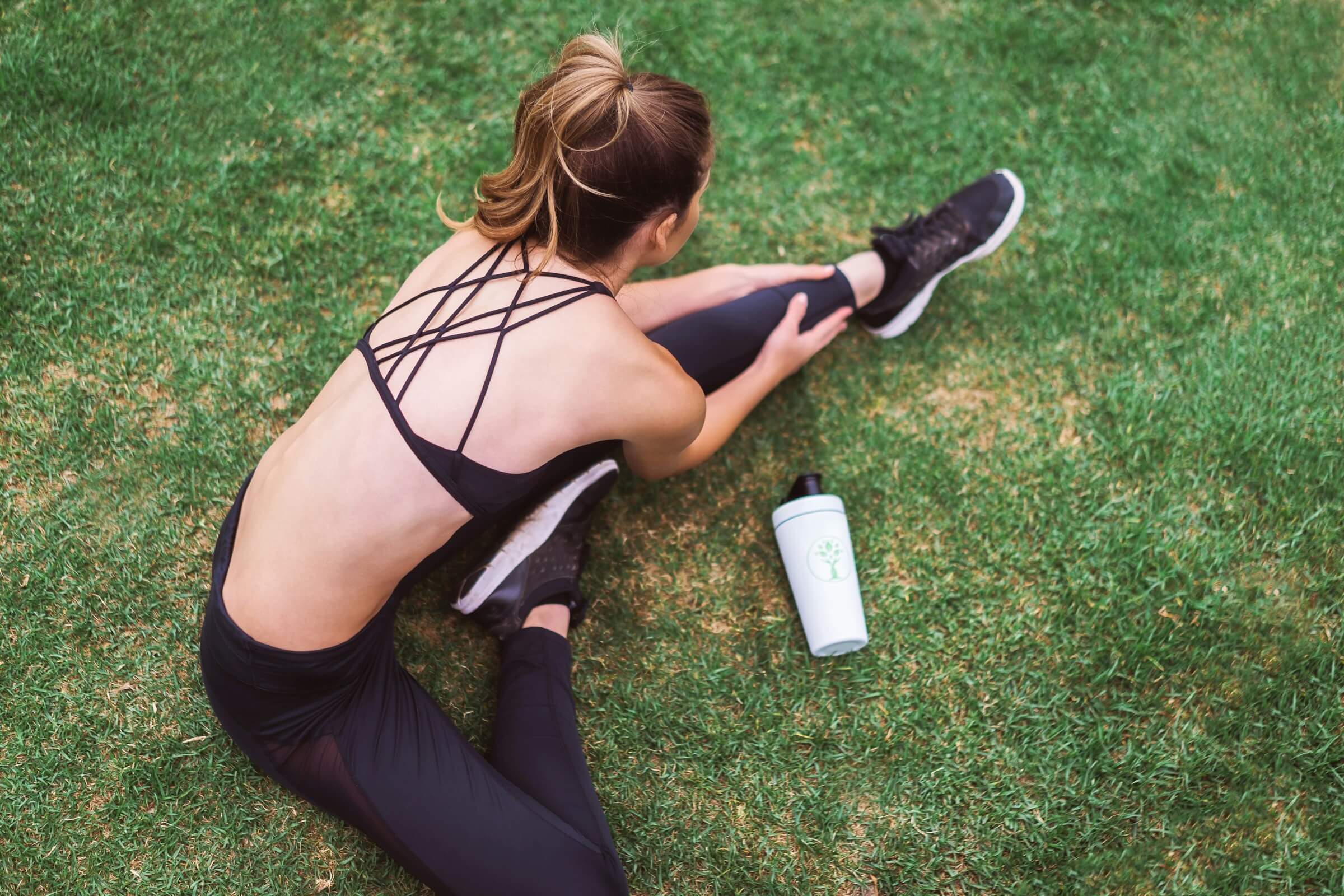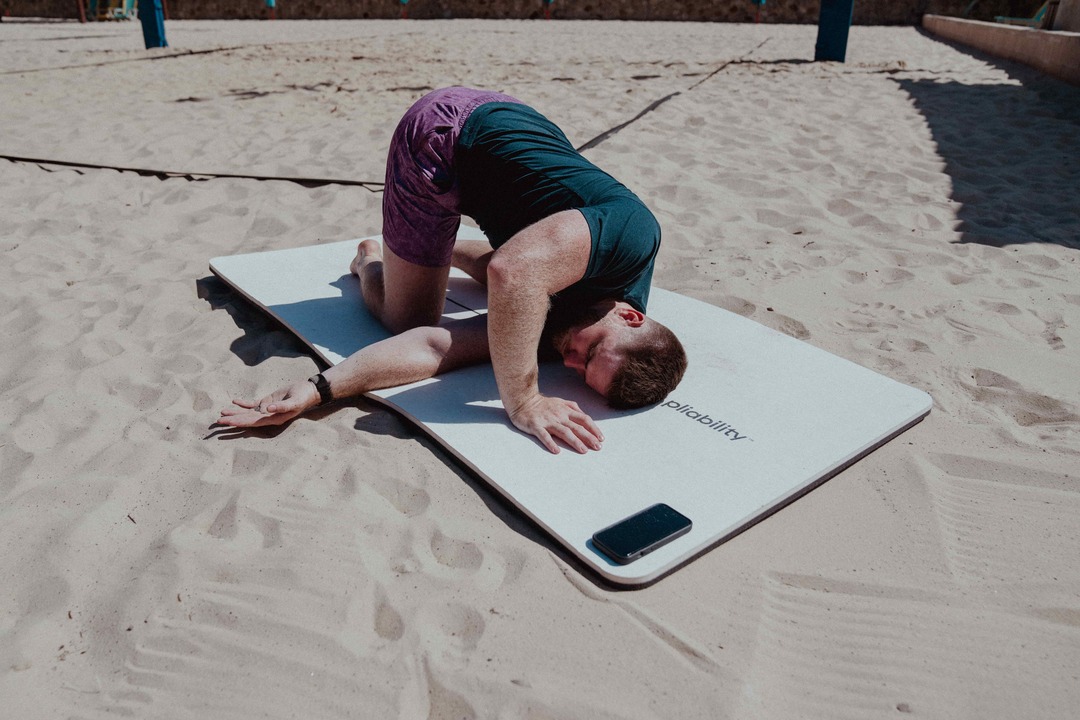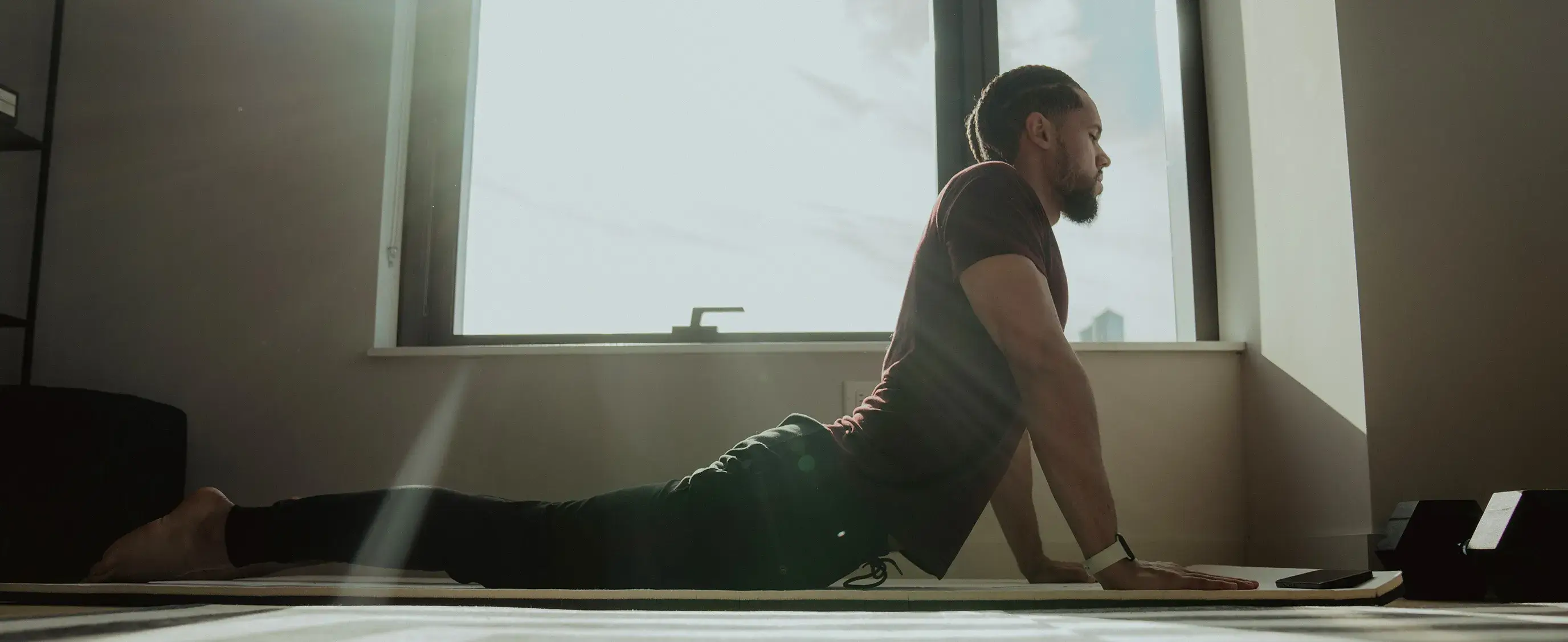Flexibility exercises are a valuable part of any fitness routine. They help improve your range of motion, enhance performance, decrease stiffness, and reduce injury risk. However, many people struggle to get started and follow a flexible routine. If you can relate, you might wonder, “How many days per week can you perform flexibility exercises?” This article will help you answer this question to establish an effective flexibility routine that enhances mobility confidently, reduces stiffness, and supports an active, pain-free lifestyle.
One helpful solution to get you there is Pliability's mobility app. This easy-to-use tool can help you achieve your flexibility goals and get you on track to a routine that will boost your performance, alleviate aches and pains, and enhance your quality of life.
How Many Days Per Week Can You Perform Flexibility Exercises?

Flexibility exercises are activities that improve the ability of a joint to maintain the movement necessary for carrying out daily tasks and physical activity.
Examples of flexibility activities include:
- Stretching
- Yoga
- Tai chi
- Pilates
Muscle-strengthening activities help maintain the ability to perform everyday tasks and slow down the bone and muscle loss rate associated with aging. Such exercises can also help reduce your chances of falling.
Health professionals believe that improving your flexibility can improve your posture, reduce aches and pains, and lower your risk of injury. Flexibility can also help you to continue carrying out everyday tasks.
How Often Should I Do Strength and Flexibility Exercises?
It's a good idea to do muscle-strengthening activities that work all the major muscle groups (legs, hips, back, abdomen, chest, shoulders, and arms) two or more days a week. No specific amount of time is recommended, but a typical training session could take less than 20 minutes.
Exercises should be performed to the point where doing another repetition without help would be difficult. A repetition is one complete movement of an activity, like lifting a weight or doing 1 push-up or one sit-up.
- Try to do 8 to 12 repetitions for each activity, which counts as 1 set.
- Try doing at least two sets of muscle-strengthening activities, but do three to gain even more benefits.
Remember to start gradually and build up over weeks. There are no specific recommendations for how much time you should spend on flexibility exercises.
Related Reading
- Why Is Flexibility Important
- Does Flexibility Increase Speed
- Can Anyone Become Flexible
- Does Stretching Make You More Flexible
- Why Is Flexibility Important for Team Sports
- Increase Back Flexibility
- How Long Does It Take to Get Flexible
- Which Activity Is a Type of Flexibility Exercise?
- Sports That Require Flexibility
- What Is the Best Strategy to Improve Flexibility in Your Legs and Back
- Mobility vs Flexibility
- Sports That Require Flexibility
Why are Flexibility Exercises Important?

Flexibility exercises are vital to improving a person's overall health and performance. “Our muscles move our joints, so if they are stuck in a state of contraction or weakness over a period of time, those joints will become more stiff, painful, and degenerate,” says Ashley Cruz, a chiropractor and founder of Cruz Chiropractic Wellness in New York City. “This can have a negative effect on our overall health.” Flexibility stretches help prevent this stagnancy by improving health and performance. When we do not stretch regularly, we can develop chronic tightness, which may increase our risk of injury, affect how we move, and limit our performance.
Adding stretches for flexibility to your regimen is also essential when optimizing your fitness routine, whether at the gym, through free workout apps, or via YouTube workouts. “If you're going hard in the gym and not stretching and notice things feeling tight or aggravated regarding my joints, try adding in a little stretching to see if it helps alleviate some of this discomfort,” says Jake Boly, a strength coach and founder of That Fit Friend. “A lot of this is contextual and individual, so don't be afraid to play with different stretching styles and protocols to see what helps you feel your best.”
Flexibility Exercises: So Much More Than Stretching
Flexibility exercises improve a person's range of motion and relieve joint stiffness. “Flexibility helps a person do things like run or bend down to pick up their child instead of relying heavily on specific muscles, thus helping to prevent overuse,” says physical therapist Neil Guintu, DPT, at Ascent Physical Therapy in New York City. “Without healing or retraining the area, chronic tightness may occur.” Flexibility also promotes relaxation, decreasing stress and anxiety, enhancing overall mood, and improving athletic performance.
These exercises help everyone, from sedentary individuals to elite athletes. “Movement of our joints through daily mobility and exercise allows nutrient-rich synovial fluid [found in between your joints] to bathe them, optimizing their function,” says Dr. Cruz. Taking a more active approach with stretching exercises, she says, “helps to essentially ‘floss your joints’ and rid them of the tension that develops throughout the stagnancy of the workday.”
The Secret to Staying Flexible: Consistency
Flexibility exercises can be performed by anyone at any age. “Younger individuals may have a bigger bandwidth of improvement with flexibility, but soft-tissue structures [i.e., muscles] can improve at any age with movement,” says Guintu. Staying consistent with a stretching routine is the best thing you can do for your flexibility training. So is building muscle. “Creating strong muscles surrounding our joints is the best way to increase our flexibility and keep it for years to come,” says Cruz.
How to Start Stretching for Flexibility
When starting, remember that slow is always the best way to go. “Keep it simple by starting incrementally, go slow, and control movements to smaller ranges or a single body part," says Guintu, who adds that a custom stretching routine should always follow a proper assessment by a movement professional. “Then increase the movements more dynamically, increase the speed, ranges, and maybe even target multiple areas of the body.”
Another rule of thumb to remember when learning to improve flexibility is to perform dynamic stretches, which require repetitive movements before working out, and static stretches, which require holds after your workout and before you cool down. The reason? “Static holds are best after physical exercise while the muscles are warm enough to hold certain stretches without pain or stress,” says April Sutton, a personal trainer and stuntwoman known for her work in Divergent, Empire, and more.
Stretching is for Everyone
Anyone at any fitness level can stretch and get flexible. It’s just taking your time and welcoming modifications wherever needed. You know your body and its capabilities best. “Don’t fall into the trap of thinking you need a certain level of mobility before you can train with an exercise or movement,” says Boly. “There's typically always a way to work around a mobility limitation and in many cases simply training the exercise you feel limited with can be useful for improving mobility.”
Related Reading
- Why Is It Important for Athletes to Be Flexible
- Flexibility Sports Examples
- How to Become Flexible if You Are Very Stiff
- Flexibility Exercises for Kids
- Flexibility Exercises at Home
- How Can Flexibility Training Reduce the Risk of Back Pain?
- Flexibility Exercises for Beginners
- How Frequently Should Flexibility Exercises Be Performed for Best Results?
- Benefits of Flexibility
- Flexibility Workout Plan
- Types of Flexibility Exercises
- Back Stretches for Flexibility
- Strength and Flexibility Training
- Exercises for Lower Back Pain
- How to Stretch Quads
- Morning Stretch
- Best Quad Stretches
- At What Average Age Does Flexibility Start to Diminish for Most People?
- IT Band Stretches
- IT Band Stretch
- IT Band Exercises
- Inner Thigh Stretches
- Cool Down Stretches
- Standing Quad Stretch
12 Best Flexibility Exercises for Better Mobility

1. Standing Calf and Achilles Tendon Stretch: A Commonly Neglected Flexibility Exercise
“Our calves and achilles are so tight from day-to-day use,” says Sutton of this flexibility exercise and calf stretch. “Stretching these muscles will help decrease the likelihood of sprained or torn ankles.”
How to:
- In a staggered stance, place your hands against a wall.
- Place one foot on a flat surface while bending the same knee toward the flat surface.
- The foot should be glued to the surface while applying weight on the heel or feeling a slight stretch in your achilles and calf muscles.
- The heel and the bottom of the foot should be glued to the flat surface.
- Hold for 10-30 seconds.
- Release and repeat as needed.
2. Staggered Hamstring Stretch: A Commonly Neglected Flexibility Exercise
“This helps stretch the isolated hamstring and helps with stretching out the lower back,” says Sutton. “Tight hamstrings can have a big effect on hips and the lower back.”
How to:
- Extend one leg with the ankle flexed (toes pointing up) in a staggered stance while the other leg is slightly bent.
- Both knees should be aligned while maintaining a flat back.
- Reach hands toward the flexed foot with palms facing up until you feel a slight pull of the hamstring.
- Hold for 10-30 seconds.
- Release and repeat as needed.
3. Figure-Four Stretch: A Commonly Neglected Flexibility Exercise
“This stretch helps to increase flexibility in the glutes, hips, and lower back,” says Sutton. “For a deeper stretch, place your hands on your knees.”
How to:
- Lying flat on your back, bend both legs at a 90-degree angle.
- Place one ankle on the opposite knee.
- Fold your hands and place them on your hamstring or knee.
- Slightly tug your knee toward your chest until you feel tension in your glutes and hip.
- Hold for 10-30 seconds.
- Release and repeat as needed.
4. Seated Quad Stretch: A Commonly Neglected Flexibility Exercise
“Not only does this stretch focus on quads, but also biceps and even the anterior tibialis [muscle on top of foot],” says Sutton.
How to:
- Start by sitting on top of your heels.
- Place your hands on a flat surface behind your shoulders.
- Hands should be facing away from you, and arms should be fully extended with biceps facing forward.
- Lean back while opening up your chest and pulling your shoulders back.
- The farther you lean back, the deeper your quads and biceps stretch.
- Hold for 10-30 seconds.
- Release and repeat as needed.
5. Child's Pose: A Commonly Neglected Flexibility Exercise
Anyone familiar with yoga poses will recognize this one. “Child's Pose allows for gentle spine decompression that can be done anywhere,” says Cruz. “For a little spice, alternate elongating your reach for a deeper stretch.”
How to:
- Start with kneeling on the floor.
- Sit back on your heels and lean forward.
- Rest your head on the floor and extend your arms.
- Hold for 10-30 seconds.
- Release and repeat as needed.
6. Wall Slide: A Commonly Neglected Flexibility Exercise
“This move is great for chest mobility,” says Guintu, who cites strength training as another avenue to increase flexibility. Someone with limited shoulder mobility will benefit from using their shoulder against resistance to build more tolerance and capacity.
How to:
- Stand against a wall, ensuring your upper back, arms, and head touch the wall.
- Raise your arms over your head.
- Bend your arms so they're close to your sides.
- Hold for 10-30 seconds.
- Release and repeat as needed.
7. Sleeper Stretch Shoulder Rotation: A Commonly Neglected Flexibility Exercise
“When we have adequate thoracic rotation, less stress is put on the neck and lower back joints, ultimately leading to less frequent injury and pain,” says Cruz.
How to:
- Lie on your side and create a 90-degree angle with the arm closest to the floor.
- With your other hand, grasp your wrist and slowly bring your forearm down.
- Hold for 10-30 seconds.
- Release and repeat as needed.
8. 90/90 Hip Stretch: A Commonly Neglected Flexibility Exercise
“This move challenges your hips to enter their full range of motion while providing a great stretch to the muscles controlling them, usually a key component in those with lower back pain,” says Cruz.
How to:
- In a seated position, bend your legs at a 90-degree angle.
- Place hands just outside your shoulders with an open chest.
- Tilt knees toward the flat surface while maintaining a 90-degree angle in both legs until tension builds in hips.
- Hold for 10-30 seconds.
- Release and repeat as needed.
9. Cat-Cow: A Commonly Neglected Flexibility Exercise
“This movement works the spine into maximum flexion and extension, which then allows for full movement in other ranges of motion, such as rotation,” says Cruz.
How to:
- Get on all fours with your shoulders right over your wrists and your knees below your hips.
- Exhale to scoop and round your back.
- Tuck your pelvis back. Inhale and reach the tailbone up.
- Scoop and round your back. Hold for 10-30 seconds. Release and repeat as needed.
10. Lunged Lower Back and Glutes Stretch: A Commonly Neglected Flexibility Exercise
Looking for back stretches for flexibility? This lower-body exercise can be incorporated into any workout routine. “The less tight the glutes, the less susceptible you are to hip flexor tightness,” says Sutton. “I recommend this stretch after running or cycling.”
How to:
- Take one big lunge forward and place your palms on the flat surface.
- Hands should be directly underneath your chest in between hips to start.
- Bend one leg with one foot outside your hand while the other fully extends.
- Twist the torso, bringing both arms alongside the bent knee like a helicopter.
- Torso should be fully rotated while the chest remains open, facing the bent knee.
- Hold for 10-30 seconds.
- Release and repeat as needed.
11. Deep Squat Stretch: A Commonly Neglected Flexibility Exercise
“I love doing this stretch before I squat a barbell,” says Sutton, adding that this type of stretching can help prevent groin muscle injuries. “Squatting with better range of motion will prevent any discomfort in the lower back and knees.”
How to:
- Start in a standing position with legs shoulder-width apart.
- Drive glutes downward past hips as if you're squatting.
- Keep feet flat.
- Place both elbows inside the legs along both knees.
- Put your palms together and pull your shoulders back.
- Utilize arms to open hips for a deeper stretch.
- Hold for 10-30 seconds.
- Release and repeat as needed.
12. Standing Straddle Stretch: A Commonly Neglected Flexibility Exercise
“This stretch helps increase blood flow in the inner thighs and hamstrings as well,” says Sutton. “It's an intense inner leg stretch that can do wonders for your hips, core, and spine.”
How to:
- While standing, adjust your legs into a vast, split-like stance so your legs are fully extended.
- Keep feet flat and neutral.
- Place both palms flat and directly underneath the chest while tucking the chin. Hold for 10-30 seconds.
- Release and repeat as needed.
Related Reading
- Leg Flexibility Exercises
- Muscular Flexibility Exercises
- Pliability vs Flexibility
- Flexibility Workout
- Flexibility Routine
- Best Stretches for Flexibility
- Best Flexibility Apps
- StretchIt vs Pliability
- Bend vs Stretchit
- Bend App Alternative
- Band Stretches
- Side Stretches
- Stretches for Sore Legs
Improve Your Flexibility with Our Mobility App Today | Get 7 Days for Free on Any Platform
Pliability offers a fresh take on yoga tailored for performance-oriented individuals and athletes. Our app features a vast library of high-quality videos designed to improve flexibility, aid recovery, reduce pain, and enhance range of motion.
Pliability provides daily-updated custom mobility programs for those interested in optimizing their health and fitness. It also includes a unique body-scanning feature to pinpoint mobility issues. If you're feeling limited by pain or your ability to move, Pliability aims to complement your fitness routine and help you move better. Sign up today for 7 days absolutely for free, on iPhone, iPad, Android, or on our website to improve flexibility, aid recovery, reduce pain, and enhance range of motion with our mobility app.







